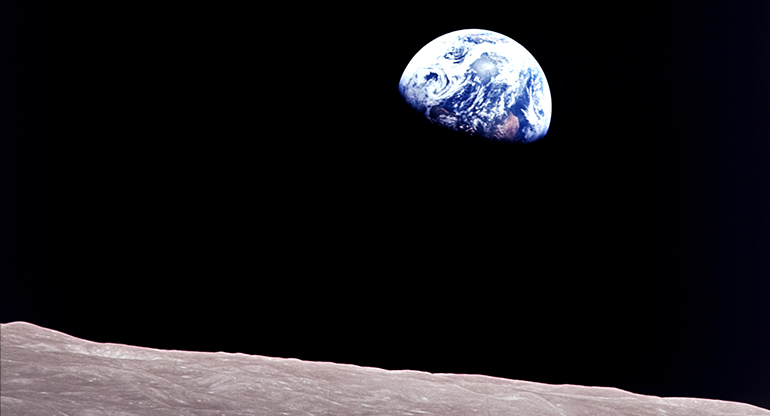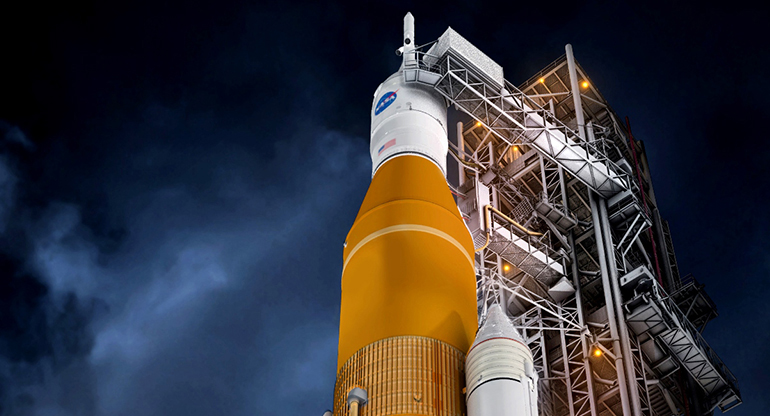Celebrating 60 years in space
SAIC has been working alongside the space community on some of the greatest missions in U.S. history.
We don't just know space exploration. We've lived it, from designing inertial navigation systems in the 1950s to conducting independent verification and validation for the very first heavy-lift reusable rocket launch in 2018.
Apollo 8 50th anniversary
On Dec. 21, 1968, Frank Borman, Jim Lovell, and Bill Anders launched into space in the first crewed spaceflight to leave Earth's orbit and circle the moon. Three days later, the astronauts held a live broadcast from lunar orbit, in which they showed pictures of the Earth and the moon as seen from their spacecraft. That same year, we were working with NASA to produce Phase A designs for the Space Shuttle.
On Dec. 21, 2018, we commemorated the historical event as NASA held its golden anniversary celebrations.
We have built a history of space age past and present:
- In 1969, when the world watched in awe on black-and-white television sets as Neil Armstrong and Buzz Aldrin made their first steps on the moon in the Apollo 11 mission, our engineers were designing and analyzing the next generation of space systems.
- Over the last four decades, we have supported 240 government space and missile launches.
- Since the 1990s, we have provided launch and mission assurance for the intelligence and defense communities in protection of the nation's security.
- In 2012, our systems engineering and integration teams ensured that the Curiosity Rover's "Seven-Minutes-Of-Terror" landing was successful for its scientific discovery journey across Mars.
- We have supported International Space Station safety for more than 25 years--from assembly through continuous operations. Today, SAIC engineers ensure the safety of our astronauts from onboard life support systems to space suits and space walks.
- We are there every day working with the U.S. Air Force to support the design and deployment of next-generation ground systems and space systems that can stand up to the challenges of contested space.
Space Launch System software assurance
Plans for human exploration of Mars rely on the Space Launch System (SLS) -- a rocket more powerful than the Saturn V. Our software assurance team is helping NASA with the challenge of ensuring that the SLS operates safely and as intended.
We assure that the software and its related products meet their specified requirements, conform to standards and regulations, and are consistent, complete, correct, and safe. These activities improve the quality of the flight software by eliminating defects and provides NASA with confidence that the software will operate safely and meet mission objectives.
Close encounters of the solar kind
NASA's Parker Solar Probe is getting closer to the sun than any other man-made object before it. Launched in August last year, it will provide mankind its closest-ever observations of a star while facing extreme heat and radiation.
Our team has helped provide assurance for critical mission capabilities that software on the spacecraft enables. By simulating the spacecraft dynamics, we put the software through the paces, seeing firsthand how the spacecraft would react to more than 100 scenarios.
The sun's atmosphere is 300 times hotter than its surface. Among other engineering challenges we helped to solve, we inspected guidance, navigation, and control software to ensure that the probe's unique heat shield is always oriented correctly to keep the probe from burning up.
Scientists hope that the probe can solve mysteries such as how the solar corona and wind are heated and accelerated to become solar storms and flares.
Extreme space weather can cause adverse events on Earth, including power grid fluctuations, damage to Earth-orbiting satellites, degradation of high-frequency radio signals, and exposure to higher-than-normal radiation levels.
Shaping the space for decades to come
Our teams are innovating and creating new capabilities, whether they are in:
- Systems engineering and integration, including model-based systems engineering, policy and strategy, space enterprise architecture, and digital engineering.
- Launch and mission safety and assurance, including vulnerability and resilience assessment, risk management framework, test and evaluation, and cyber hardening.
- Hardware and software integration for space and related ground systems
- Software assurance
- Satellite command and control and exploration ground systems, including agile integration, open architectures, cloud migration, and AI and ML-assisted decision-making.


